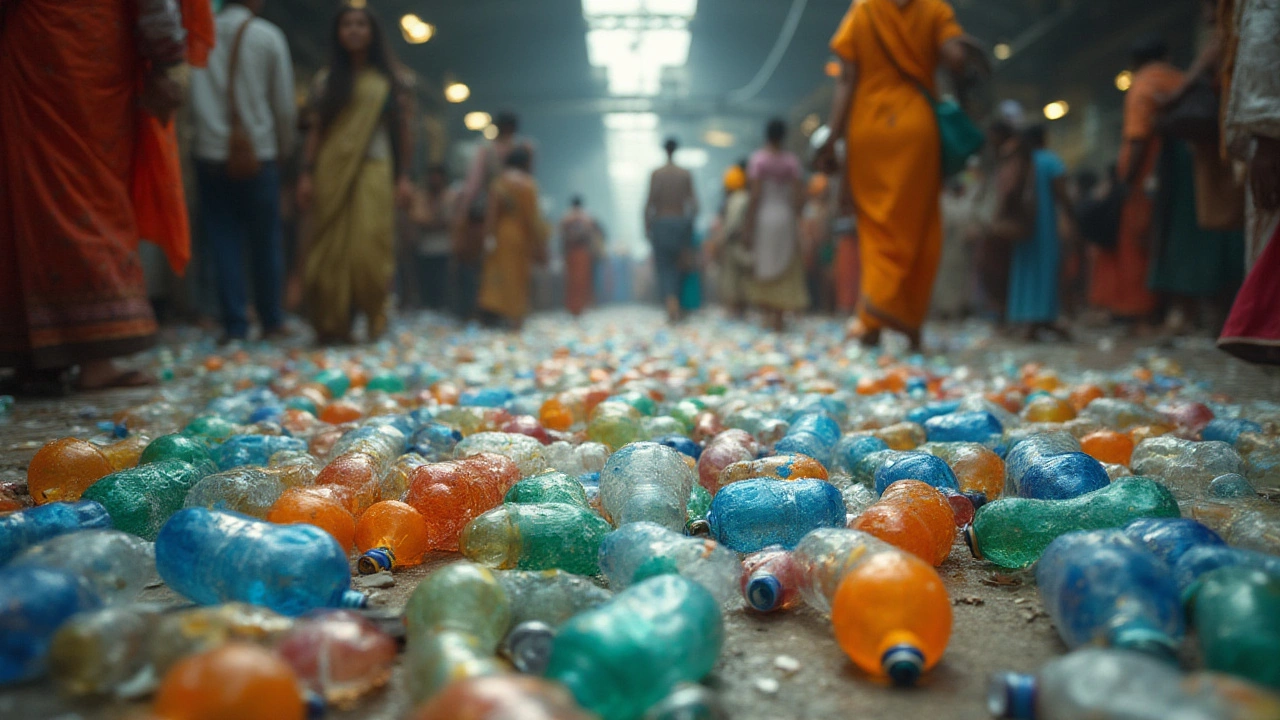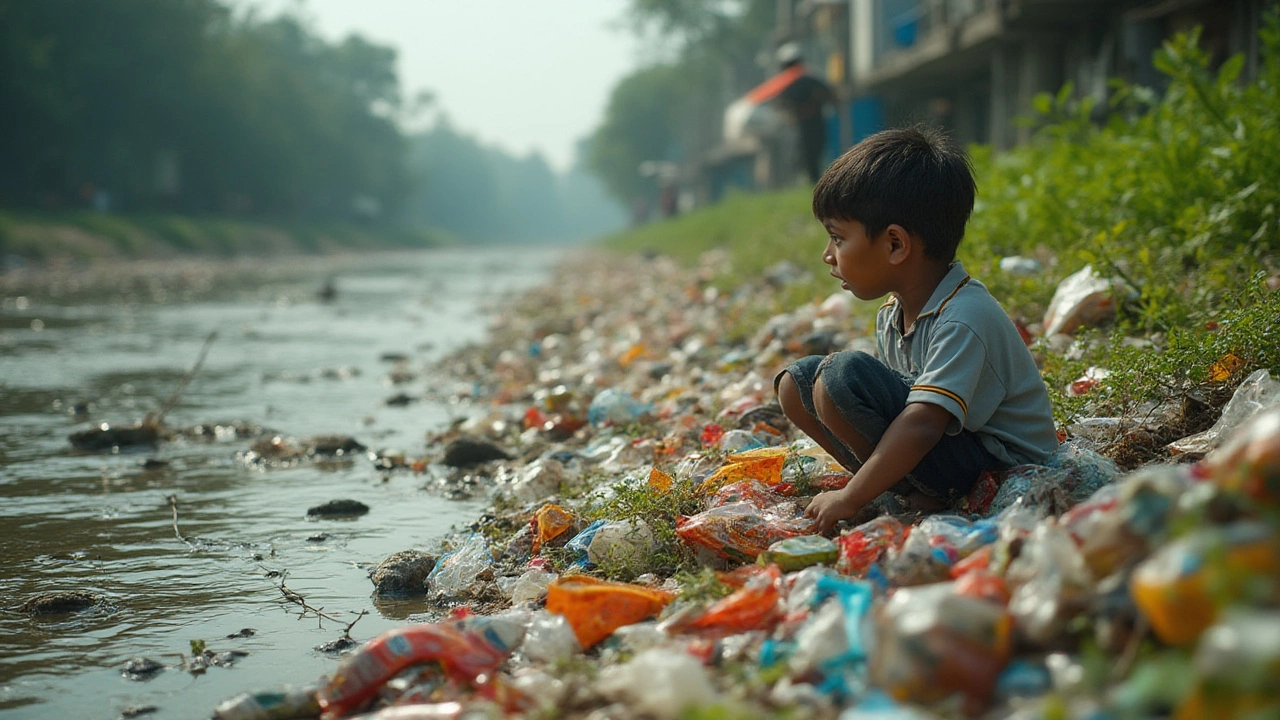 Jul, 22 2025
Jul, 22 2025
Chances are, you’ve touched this plastic today. It’s everywhere—wrapped around sandwiches, crumpled in car glove boxes, drifting like artificial jellyfish in rivers, clogging landfills and swirling out at sea. Most folks think of straws or water bottles, but the real heavyweight in the ring of single-use plastics might surprise you.
The Reigning Champion: Plastic Bags and Beyond
Plastic bags top the pile as the most widely used and heavily discarded single-use plastic on the planet. You see them at every grocery store, market stall, and shopping mall. By some estimates, about 5 trillion plastic bags get consumed globally every single year. That works out to about 160,000 bags per second. You can probably picture grabbing a couple with your lunch or packing up leftovers—multiplying that by everyone on earth, and the scale gets wild fast.
For most folks, a plastic bag is just a convenience, something to hold your takeout or line the trash can. The bitter truth is that nearly every plastic bag ever made still exists somewhere—breaking down into tinier and tinier fragments, but never really going away. One study found that less than 10% actually gets recycled. The rest mostly goes to landfills, or, worse, finds its way into oceans, rivers, and the bellies of unsuspecting animals.
But why are plastic bags so popular? They’re cheap—far cheaper than most alternatives. They’re light, strong, and perfectly waterproof. That makes them tricky to replace for day-to-day life, especially in places where alternatives are either hard to come by or too expensive for the average household. In fast-growing economies, where retail and food service industries are booming, bags practically fly out the door by the millions.
What about other big single-use plastics? Plastic water bottles, straws, coffee cup lids, and food wrappers also play starring roles. But plastic bags still have the edge in sheer numbers and global reach. They turn up in places as unlikely as mountain peaks and the Mariana Trench. If you stacked up all the single-use plastic bags thrown out in one year, you’d circle the globe about seven times. That is literally mountains of plastic, just from bags alone.
| Single-Use Plastic Item | Annual Global Usage (approx.) |
|---|---|
| Plastic Bags | 5 trillion |
| Plastic Water Bottles | 500 billion |
| Plastic Straws | 100 billion |
| Food Wrappers | 500 billion |
| Coffee Cup Lids | 250 billion |
How Did Plastic Bags Become Ubiquitous?
The story of plastic bags is actually pretty recent. They burst onto the retail scene in the 1960s. Originally, some companies even sold them as a greener option, a way to save trees by using less paper packaging. Svenska Cellulosa Aktiebolaget, a Swedish company, patented the modern polyethylene bag in 1965. By the 1980s, most supermarkets in North America, Europe, and Asia rolled out plastic bags as the default choice at checkout.
Back then, nobody really thought about what might happen decades down the line. They saw a strong, lightweight, and endlessly convenient material. But then, as the 21st century rolled in, the tide turned. Photos of whales and seabirds tangled in bags, beaches covered in shredded plastic, and microplastics showing up in bottled water and even the air—these images started changing public opinion.
Still, the economic forces driving plastic bag use haven’t slowed as much as you might hope. A big part of the problem is their dirt-cheap production cost. It takes about one cent to make a polyethylene bag. For small businesses and street vendors, the price difference compared to paper or cloth adds up fast.
Populations in Africa and Southeast Asia often rely on plastic bags for daily shopping or to take home water—yet these regions also face weak waste management systems. This is why the world’s top 10 rivers carrying plastic into the ocean can be traced to countries with high rates of single-use plastic and low recycling.
Bans and taxes are the main tools governments use to slow the spread. In 2002, Bangladesh became the first country to slap a ban on thin bags after flooding was made worse by blocked drains stuffed with plastic. Kenya followed much later, creating one of the world’s toughest bans, where offenders can face jail time or hefty fines.
But for every place that cracks down, there are dozens more where bags flow unchecked. So the question lingers: is there a better way forward, or are we stuck with this plastic tide?

The Environmental Impact: More Than Meets the Eye
If you’ve ever watched a plastic bag fluttering on the wind, it doesn’t seem dangerous. The problem is what happens next. Bags wind up in lakes, streams, and oceans, where they snarl up ecosystems in ways you might not expect. Sea turtles easily mistake floating bags for jellyfish—and end up choking or starving. Dolphins and seabirds swallow fragments, thinking they’re food, and die from blocked stomachs.
But the issues don't stop with wildlife. Plastic bags break down into smaller and smaller pieces, eventually becoming microplastics. These tiny grains pass straight through water treatment plants and into the food chain. A study published in Environmental Science & Technology showed that humans ingest about 5 grams of plastic every week—the weight of a credit card. That comes from seafood, tap water, and even the air we breathe.
Landfills are no safer. Bags packed under layers of waste don’t decompose for centuries. Some researchers say it can take up to 1,000 years for a single bag to break down, and even then, it just becomes microplastic. Some of today’s landfills basically serve as time capsules for future generations to open.
The plastic industry sometimes argues that bags use less energy to make and transport than paper or cloth, and that’s technically true. But their tiny size and low density make them nearly impossible to collect and recycle profitably. As a result, most curbside recycling programs don’t accept them at all, since they jam up sorting machines. Even when people use bins set up at grocery stores, recycling rates barely scratch the surface because it’s labor-intensive to separate and clean bags suitable for turning into new products.
Communities pay the price. Municipalities worldwide spend millions of dollars cleaning up plastic bag litter and clearing blocked drains every year. In some U.S. cities, bags make up a good chunk of storm debris after heavy rain, contributing to flooding and expensive repairs.
There’s a ripple effect on public health, too. Bags that pile up in street corners collect rainwater, creating breeding grounds for mosquitoes. Some developing urban areas have seen upticks in diseases like dengue fever and malaria as a direct result of plastic bag waste.
| Environmental Impact | Consequence |
|---|---|
| Wildlife | Ingestion, entanglement, deaths |
| Landfills | Persistent microplastics, 1000-year breakdown |
| Flooding | Blockage of waterways, increased flood damage |
| Human Health | Microplastic ingestion; mosquito-borne diseases |
What You Can Do: Smarter Choices and Fresh Solutions
The numbers sound daunting, but that doesn’t mean you’re powerless against single-use plastic bags. Change always starts small—every bag refused or reused makes a difference at scale. Start by saying ‘no thanks’ at the checkout counter or, even better, stash a foldable cloth tote in your backpack or car. That’s one less bag in circulation.
Next, bring awareness to your circle. Most people don’t realize that even trash bags and pet waste liners contribute to the same problem. Some cities now give out compostable or biodegradable bags, but be wary: most ‘biodegradable’ plastics only break down under industrial conditions, not in regular landfill or home compost heaps. Check for certification labels before assuming a product is a friendly alternative.
Get involved locally. Towns and cities listen when residents speak up. If your neighborhood still hands out bags routinely, organize a petition or write to your local councilman. Groups like Plastic Pollution Coalition and Break Free From Plastic offer online resources, toolkits, and even ready-to-go stats you can use to power your argument.
Support businesses that have ditched single-use plastics, or that at least offer options for customers. The more consumers vote with their wallets, the quicker retailers and manufacturers take notice. And if you’re feeling ambitious, encourage your favorite retailers to invest in reusable bag incentives or recycling bins for soft plastics.
For extra credit, try these tips:
- Reuse plastic bags for storage, lining trash cans, or picking up litter while you walk the dog.
- Opt for products with minimal or no plastic packaging—instead, look for reusable containers.
- Join community clean-up days at parks and rivers in your area.
- Educate kids about plastic pollution with hands-on projects or documentaries.
- Follow the latest on smart materials—like edible packaging, mushroom-based containers, or starch-based bags—these could be game-changers soon.
Governments, non-profits, and companies are racing to find scalable options for this massive problem. In countries like Rwanda and Chile, strict bans have led to nearly spotless city streets. In others, huge cash-back programs for returned bags have helped nudge behavior. Meanwhile, tech startups are working hard on films, bags, and wrappings that break down harmlessly—and some already use recycled ocean plastic in their new products.
There’s no magic bullet yet, but each small step stacks up. Choosing a reusable option, asking tough questions at your local store, and demanding better design from manufacturers adds real pressure on the system. The world’s biggest single-use plastic might seem unbeatable, but history teaches that habits do change—one bag, one person, one day at a time. Maybe the only thing stronger than plastic is collective effort.